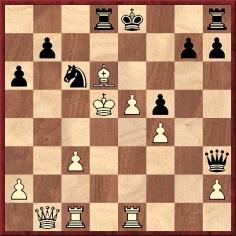Chess
Notes
|
| First column | << previous | Archives [51] | next >> | Current column |
5784. Photographs from the Amsterdam,
1954 Olympiad
John Donaldson (Berkeley, CA, USA) submits this page of photographs from the late Frank Anderson’s archives:
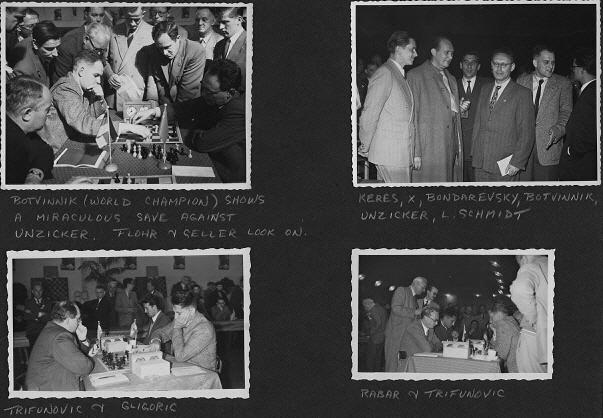
For a large version, click here.
5785. Captain Mackenzie
Joost van Winsen (Silvolde, the Netherlands) draws attention to page 195 of the United States Service Magazine, August 1864:
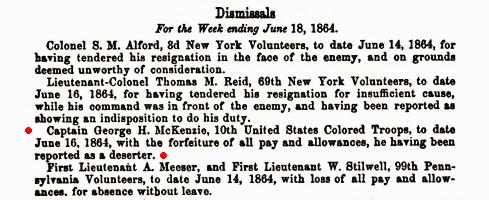
Our correspondent notes that Mackenzie’s desertion was mentioned in his entry in the Oxford Companion to Chess. Furthermore, to demonstrate that the ‘McKenzie’ referred to above was indeed the chessplayer George Henry Mackenzie, Mr van Winsen quotes a passage by Gustavus C. Reichhelm in his chess column on page 7 of the Philadelphia Evening Bulletin, 6 February 1864:
‘Our readers will probably remember the arrival in New York, last fall, of Mr George H. Mackenzie, an English [sic] chessplayer, who had acquired an excellent chess reputation in London. Mr Mackenzie made most creditable scores with several of the strongest players in New York, and is now engaged in the great game being played by our government against the southern rebels. We were glad to receive a letter from him this week, dating from Virginia, and signing himself with the honorable title of “Captain 10th Regiment U.S.C.T. [United States Colored Troops].”’
Below is a sketch of Mackenzie by Samuel Loyd, published in the Scientific American Supplement, 4 May 1878, page 1948:
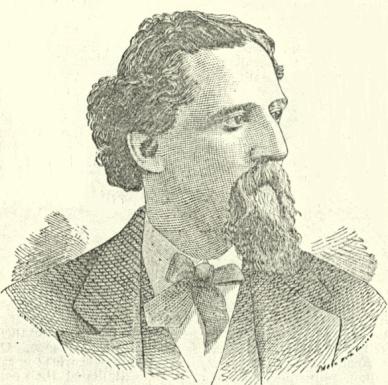
5786. Warfare
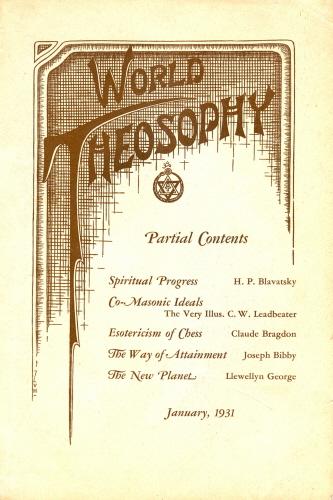
An addition to the entries listed under ‘Warfare’ in the Factfinder comes from an article entitled ‘The Esotericism of Chess’ by Claude Bragdon on pages 21-23 of World Theosophy, January 1931:
‘Chess strategy is like war strategy: in both, speed of mobilization is a determining factor; a pawn salient is like an infantry salient, pushing into the enemy country like a wedge, with flanks resting on strongholds; in both, feint and surprise attacks play an important part. Indeed, the parallel is in all ways so perfect that my friend Gelett Burgess once drew a map of a battlefield and described at great length the engagement fought thereon, and it is only at the end that the reader is permitted to discover that the whole thing is a detailed description of one of Paul Morphy’s most celebrated chess games in terms of military action. For any chess game can be described in terms of warfare and any military campaign can be re-enacted, after a fashion, with chessmen on a board.
And oddly enough, championship chess has changed in the same way as has warfare, which is no longer a thing of long-distance raids, cut off from supply bases, of brilliant cavalry charges, but is a matter of “digging in” – wars now are wars of attrition. Similarly, chess masters no longer play the old-fashioned open game, having abandoned it in favor of tactics quite similar to trench warfare. This has resulted in an increasing number of drawn games – so many, in fact, that it has been suggested that the game be made more difficult by increasing the size of the board and the number of pieces. The logical ultimate of this, as the human mind grows more four-dimensional, would be the substitution of “cubical” chess – the addition of another dimension, though now the brain reels at the very suggestion.’
5787. Birdie Reeve
Our collection includes a typescript of an unpublished novel, The Deeper Soil by I. Baumgartl (copyright 1938), which was typed by Birdie Reeve (144 pages):
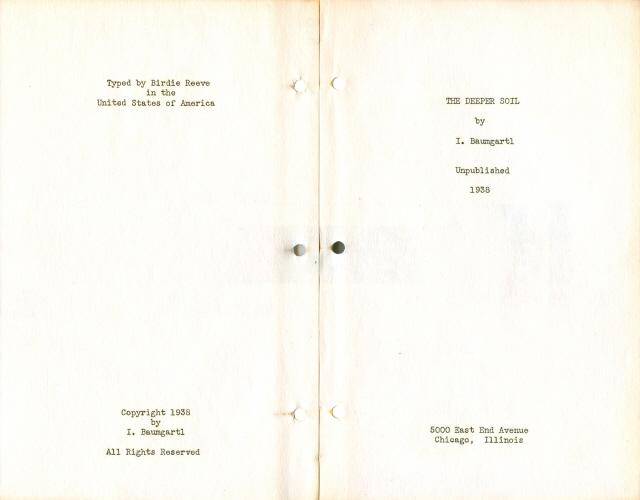
We have prepared a feature article Who Was Birdie Reeve? and
are still keen to obtain information about her chess
activities.
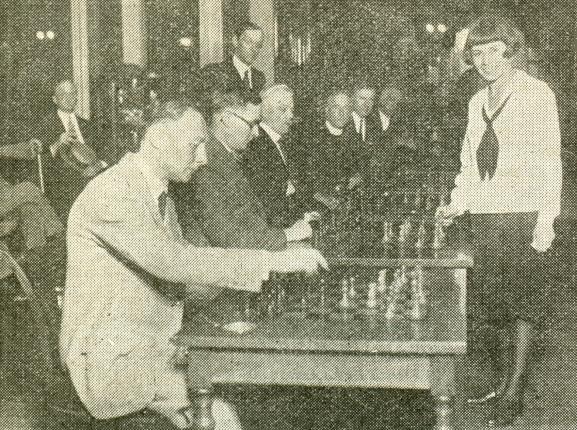
Birdie Reeve
5788. British Chess Company
Luc Winants (Boirs, Belgium) notes that although much information exists about the chess sets made by Jaques, relatively few details seem to be available about the British Chess Company. Can more be found?
As regards publishing, it may be recalled that the British Chess Company was involved in a number of titles, including the first (1896) edition of Lasker’s Common Sense in Chess.
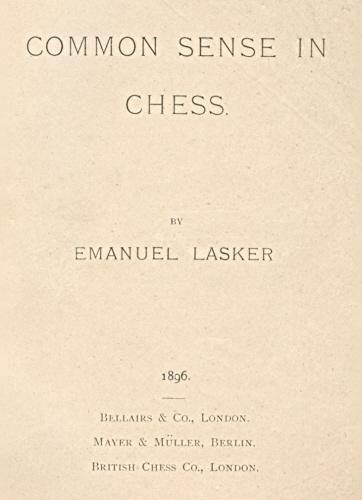
5789. Capablanca’s birth-place
Information about sites commemorating the birth-place of chess masters is being sought. Our first example is from opposite page 80 of Homenaje a José Raúl Capablanca (Havana, 1943):
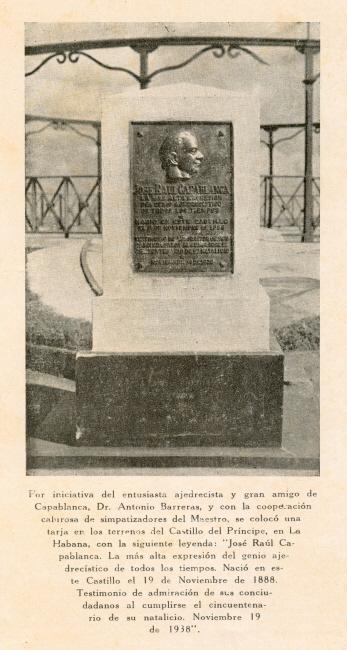
Capablanca was born in the Castillo del Príncipe, Havana, where the above tarja was constructed to commemorate his 50th birthday.
5790. Amsterdam Olympiad, 1954 (C.N.
5780)
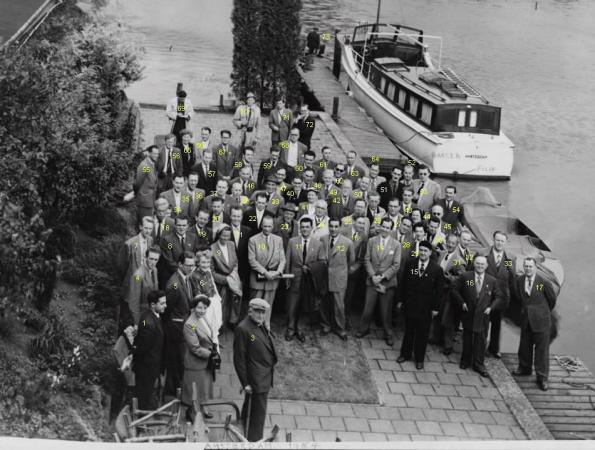
A number of figures have already been identified by readers, and we have made the photograph the subject of a feature article.
5791. Dummy pawn
Owen J. Clarkin (Ottawa, Canada) quotes from The Modern Chess Instructor by W. Steinitz (New York, 1889):
- Page xv (regarding the pawn): ‘He, however, alone of all the chessmen has the privilege of promotion, i.e. on reaching an eighth square he may be exchanged either for a queen or any other piece his player may select. The laws of the British Chess Association, which we adopt, provide that his player may refuse his promotion, in which case he remains a pawn as before, but unmovable, and he is termed a “dummy” pawn. We must, however, state that such a case can only very rarely occur in actual play, and that this law, though in our opinion theoretically sound, has little practical value for playing the game over the board, but may be of importance for the construction of problems.’
- Page xxii: ‘When a pawn has reached the eighth square, the player has the option of selecting a piece, whether such piece has been previously lost or not, whose names and powers it shall then assume, or of deciding that it shall remain a pawn.’
- Page xxiv:
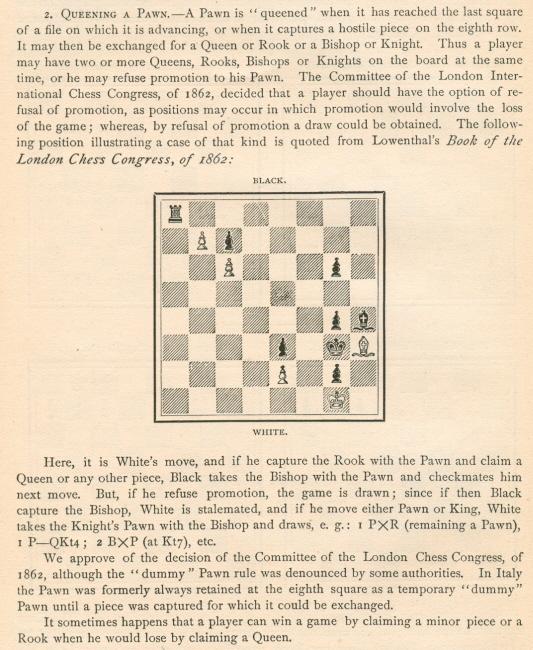
Mr Clarkin asks the following:
‘(1) Was “non-promotion” generally allowed in the mid- to late-1800s, i.e. to what extent were the Code of Laws of the British Chess Association of 1862 adopted? On page xx of his book Steinitz claimed that they were applied “... in many Chess Congresses”.
(2) What more is known about the bishop and pawn ending presented by Steinitz on page xxiv, which was given in the entry on promotion in The Oxford Companion to Chess as a composition by Kling?
(3) Are there any known instances of a pawn retaining its identity on the eighth rank in over-the-board play?
(4) Is it known whether Steinitz always supported rules allowing non-promotion?
(5) Under what circumstances was it generally decided that a pawn reaching the eighth rank must be promoted?’
We hope to revert to these matters in due course, and readers’ contributions will, as ever, be appreciated. Firstly here, it may be noted that the position given by Steinitz had appeared, attributed to Kling, on page lxxii of Löwenthal’s book on London, 1862, introduced as follows:
‘Mr Staunton maintained that to allow a pawn at its eighth square to remain a pawn was a serious innovation, a gross absurdity and a violation of the fundamental laws of the game. In reply, it was pointed out that a pawn remaining a pawn at its eighth was no novelty, Mr Staunton himself giving in the Praxis a game from Ponziani in which an example occurs; that the law relative to the point had been altered several times; that as to the reproach of innovation, the game itself was nothing but the result of a series of innovations on its original form; and that Mr Staunton had admitted in the Praxis that the tendency of modern legislation was to consider the queening a pawn as the highest feat which a player can accomplish, and to reward it with the greatest possible advantage. It was urged that to compel a player to choose a superior piece without the option of refusing promotion would not in all cases confer the greatest possible advantage, there being positions in which a player compelled to take a superior piece would be subjected to a fatal penalty, the following being an instance adduced by Mr Kling ...’
In the Kling position The Companion had a white pawn, not bishop, on h3.
As regards the game given by Ponziani, the following score appeared on pages 41-42 of Staunton’s Chess Praxis (London, 1860):
1 e4 e5 2 f4 exf4 3 Nf3 Be7 4 Bc4 Bh4+ 5 g3 fxg3 6 O-O (Kh1, Rf1) d5 7 Bxd5 Bh3 8 Bxb7 g2+ 9 Kg1 gxf1
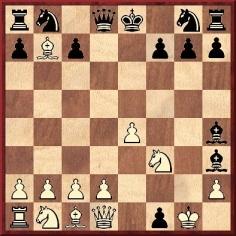
10 Bxa8 Bf2 mate.
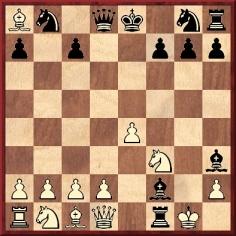
The unit on f1 had to remain a pawn until it could be replaced by a captured black piece.
Staunton wrote:
‘There is so much of the absurd about such a finale as this that no-one will consider it worthy of serious examination, and it is only mentioned as a matter of curiosity.’
Pages 219-221 of the Chess World, 1865 had a letter from W.S. Pavitt of Chelmsford on the dummy pawn (‘that exquisite stroke of chess legislation’) in the context of chess problems, and the following item was published on page 311 of the American Chess Journal, April 1879:
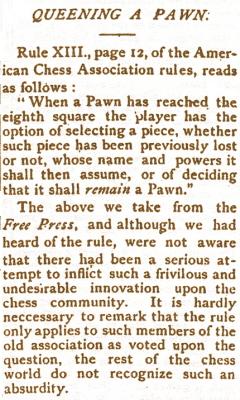
5792. Matches and tournaments
Page 159 of The Chess Scene by D. Levy and S. Reuben (London, 1974) ascribed to Tartakower the remark, ‘Matches prove less than tournaments; and tournaments don’t really prove anything either.’
What more is known about the origins of this observation (or its converse)?
5793. Encyclopaedia of games
The text below was published on page 7 of the FIDE ‘Circular Letter of the President (No. 2)’, dated 12 November 1974:

Did the plan make a start of any kind?
5794. Readership
At the end of its first year of publication the Chess Amateur (September 1907 issue, page 353) lauded itself without inhibition:
‘The phenomenal success which has attended the publication has established a record in chess literature. The Chess Amateur was the first serious attempt to issue a high-class chess monthly which would appeal to all sections of players, at a popular price, and the fact that it now boasts probably more readers than all other chess journals put together shows conclusively that its mission is being more than accomplished.’
What credibility can the boast regarding readership have? In a spat with the BCM a year later, the Chess Amateur (August 1908, page 321) merely claimed to have ‘a circulation at least twice as large as that of the British Chess Magazine’. The reply in the BCM (September 1908, pages 399-400) was that ‘the assertion is most arrogant and deliberately misleading’.
5795. More copying (C.N. 5771)
C.N. 5771 demonstrated that the text of our item C.N. 4682 (written two years ago) was recently lifted by Mr Raymond Keene for use under his own name in an article on the book Guinness World Records.
The matter has been investigated in detail at the website of the Streatham & Brixton Chess Club (reports dated 30 September, 8 October and 10 October 2008). It may be noted, in particular, that:
a) Mr Keene has made various attempts to explain his copying, and they have been proven untrue;
b) The website to which we referred in C.N. 5771 has now removed from Mr Keene’s article our paragraphs about chess;
c) Mr Keene’s article originally appeared in his weekly column in The Spectator (page 64 of the 7 June 2008 issue);
d) Over a third of ‘his’ article in The Spectator was, in fact, written by us.
5796. Saavedra
From page 34 of Kings, Commoners and Knaves (an item we wrote in 1996):
‘The gestation of the Saavedra study was documented in an article entitled “Wie was Saavedra?” by J. Selman Jr. on pages 239-244 of the November 1940 issue of the Tijdschrift van den Koninklijken Nederlandschen Schaakbond. Thanks to a detailed summary in chapter 7 of Chess Curiosities by T. Krabbé it is now widely known how a position from an 1875 Fenton v Potter match game was (incorrectly) recalled by Georges Barbier in the Glasgow Weekly Citizen of 27 April 1895, and then slightly changed the following week and called a draw for Black after 6 c8(Q). On 25 May 1895 Barbier gave the celebrated winning move found by Saavedra: 6 c8(R).’
Tim Krabbé has continued to investigate the matter. See, for instance, his article ‘The Discovery of the Saavedra’. There is also an enormous amount of information in the book No Rook Unturned by Harrie Grondijs (Rijswijk, 2004).
Joost van Winsen (Silvolde, the Netherlands) now draws our attention to the following item in the Newcastle Weekly Courant of 9 March 1895:
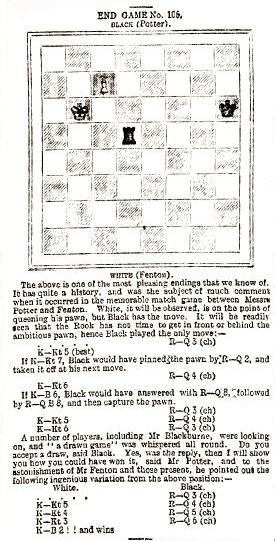
Mr van Winsen comments:
‘If faulty recollection was the first step in the Saavedra puzzle, Barbier is not to blame because the above newspaper item by H.W. Hawks, the chess editor of the Newcastle Weekly Courant, also mentioned Fenton v Potter and was published seven weeks before Barbier’s account appeared in the Glasgow Weekly Citizen. Of course, it is possible that Hawks himself copied it from an even earlier source.’
5797. British Chess Company (C.N. 5788)
From Paul Valois (Leeds, England):
‘While looking through newspaper columns, I found that between roughly October 1903 and January 1907 the British Chess Company supplied a syndicated chess column to a number of local newspapers. The ones that I have noticed so far are the Hull Times, the Northern Weekly Gazette (Middlesbrough) and the Southport Visiter. The columns were labelled “Conducted by the British Chess Company with the assistance of P.H. Williams, L. van Vliet and C.T. Blanshard”. From January 1905, it was Williams only. The columns were customized to the locality, e.g. with local lists of solvers. From January 1907, the Southport Visiter column continued “Conducted by the Editor of the Chess Amateur”. The British Chess Company was based in Stroud at that time, as was the Chess Amateur’.
We note that the front cover of the first issue of the Chess Amateur (October 1906) stated that the magazine was ‘published by H. Harmer, George Street, Stroud’ and that one of its two London agents was ‘British Chess Co., 76 Turnmill Street, EC’.
5798. Leading masters
From the archives of Frank Anderson comes this photograph (Amsterdam, 1954), forwarded to us by John Donaldson (Berkeley, CA, USA):
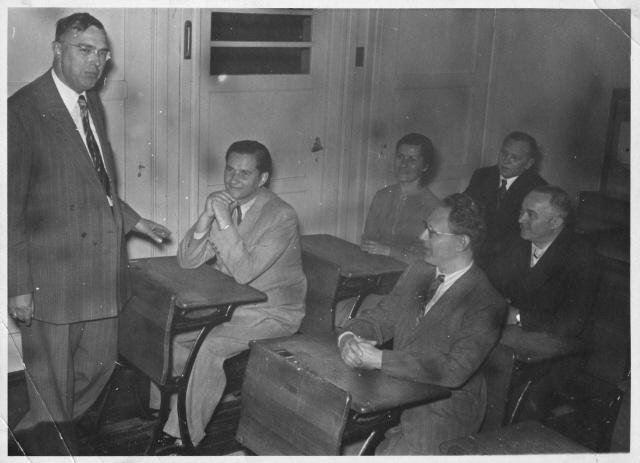
The caption on the original states: ‘M. Euwe, Keres, Mrs Botvinnik, Postnikov/Botvinnik, Flohr’.
5799. Joaquim Valladão Monteiro (C.N.s 3884, 3887 & 4173)
Leo Mano (Rio de Janeiro, Brazil) provides some information about Joaquim Valladão Monteiro.
He was born in Rio de Janeiro, but the exact date is uncertain. Page 955 of the May-August 1993 issue of the Boletim da Uniao Brasileira de Problemistas gave 15 October 1907, but a passage quoted on page 8 of his 1933 book Composições Enxadristicas stated that he was born on the eighth day of an unspecified month.
The book included this caricature:
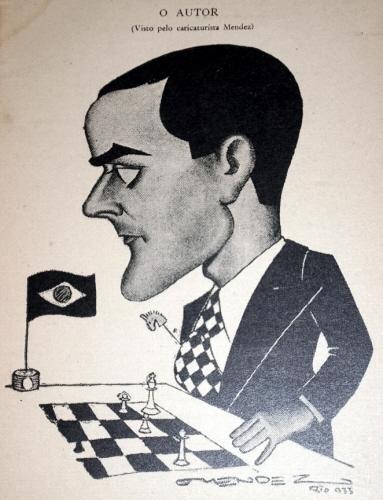
Further details about his death, in 1993, are also proving difficult to find.
Our correspondent notes that Valladão Monteiro wrote over 60 books, mainly on chess but also on poetry, Latin and literature (although nothing on medicine, which he studied in his youth).
It may be recalled that C.N. 3884 gave a photograph of him, from his book Dicionário Brasiliense do Jogador de Xadrez (Rio de Janeiro, 1956).
5800. Cambridge Springs, 1904
Tony Gillam (Nottingham, England) asks whether it is correct, as is commonly believed, that Cambridge Springs, 1904 was the first tournament to have daily bulletins. If so, which was the next tournament to receive such treatment?
The cover of one of the Cambridge Springs bulletins was shown on page 235 of David DeLucia’s Chess Library A Few Old Friends (Darien, 2007) and is given below with Mr DeLucia’s permission:
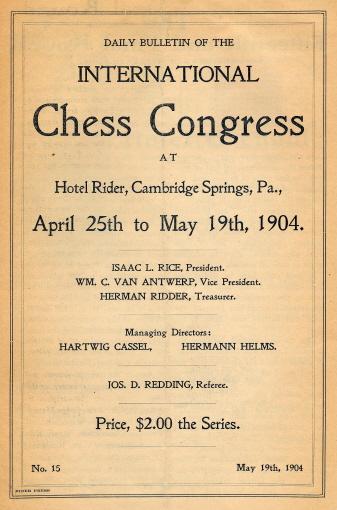
5801. Franco and Pomar (C.N. 5736)
After Javier Asturiano Molina (Murcia, Spain) informed us that a full-length picture of Francisco Franco and Arturo Pomar was published on page 50 of the 6/2002 issue of Peón de Rey, we contacted the magazine’s director, Amador Rodríguez, and he has sent us a copy for presentation here:

Mr Rodríguez comments:
‘We know for sure that Franco officially met Pomar twice, in 1944 and in 1946. From the picture, we estimate that it was most likely taken in 1946, when Pomar was 15 years old.’
5802. Nevill (C.N. 4711)

Biographical details are still being sought regarding Wallace E. Nevill, the author of “Chess-Humanics” (San Francisco, 1905). At present, all we can add is that a photograph of him was published on page 138 of the December 1904 American Chess Bulletin:
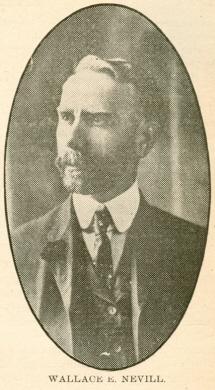
5803. Chess poetry
Wanted: information about the poet ‘Veritas’, who brought out A Selection of Poems (Bradford, 1936). Pages 25-46 comprise chess verse.
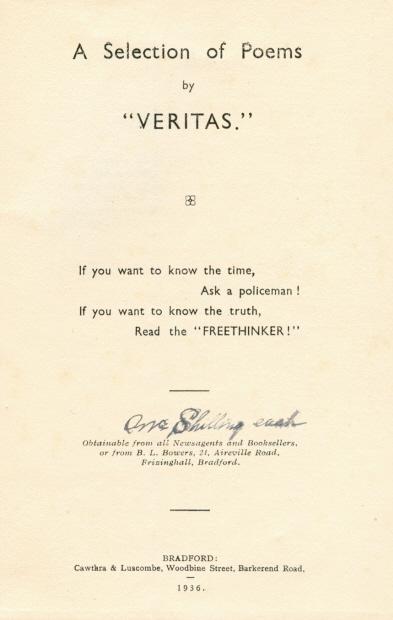
‘Veritas’ was identified on various pages as B.L. Bowers, and page 3 indicated that he was born on 15 April 1855. As shown above, the title-page stated that the book could be obtained from ‘B.L. Bowers, 24 Aireville Road, Frizinghall, Bradford’, and we note from webpages that today that is the address of a publisher of poetry, the Redbeck Press.
5804. Semana: Madrid, 1943 and an interview with Alekhine
Juan Carlos Sanz Menéndez (Alcorcón, Spain) sends us copies of the back cover of two issues of the Spanish weekly news magazine Semana, for 19 October and 26 October 1943. The former gave photographs of the participants in Madrid, 1943:
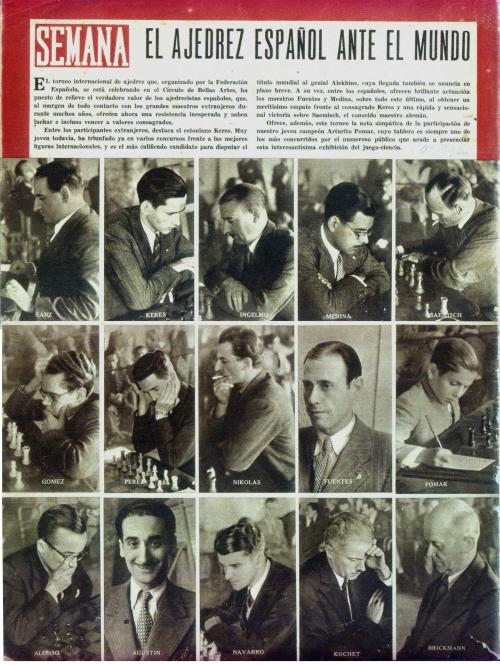
For a large version, click here.
The 26 October 1943 issue had an interview with Alekhine by ‘Austral’:

Mr Sanz Menéndez has kindly provided a transcript:
‘ALEKHINE NOS DICE:
“CUANDO JUGUE MI PRIMERA PARTIDA DE AJEDREZ, A LOS SIETE AÑOS, Y LA PERDI, ME ECHE A LLORAR”EL CAMPEON MUNDIAL DE AJEDREZ ES UN ABOGADO CRIMINALISTA;
ES TAMBIEN PERIODISTA, Y HA ESCRITO MAS DE DIEZ Y OCHO LIBROS DE CRIMINOLOGIA Y AJEDREZ– ¿Cómo le vino la idea de jugar al ajedrez?
– Pues vea usted, en casa. Mi difunto hermano mayor jugaba siempre al ajedrez. Le había visto jugar muchas partidas, cuando un día – tenía unos siete años – me puse a jugar por mi cuenta. Mi adversario tenía por lo menos veinte años más que yo. Naturalmente, perdí. Me impresionó tanto la derrota que me eché a llorar. Desde aquel día me propuse llegar a ser tan buen ajedrecista que nadie pudiera vencerme.
El hombre que nos habla así es Alekhine, el campeón mundial de ajedrez, que acaba de llegar a España donde pensó participar en el torneo internacional de ajedrez de Madrid.
Es un hombre alto y fuerte, que habla corrientemente cuatro idiomas: el ruso – porque Alekhine es de origen ruso, naturalizado francés –, el francés, el alemán y el inglés. Además, habla un poco el español, el portugués, el holandés, el chino, el japonés y otros idiomas, pues como ha dado la vuelta al mundo, en todos los países ha aprendido algunas palabras.
– El único país del mundo que no conozco – nos dice – es Australia.
Cuando Alekhine juega, no sonríe nunca. Sus ojos azules, muy claros, toman una expresión dominadora. Se ve que es el Napoleón del ajedrez.
“YO SOY PERIODISTA Y CRIMINALISTA”
– ¿Es usted doctor en Medicina?; porque todos le llaman doctor.
– No; soy doctor en leyes. Como aún no existe profesionalismo en el ajedrez, hago muchas otras cosas. He escrito más de diez y ocho libros ...
– ¿Sobre ajedrez?
– Algunos sobre ajedrez; pero los demás, sobre temas muy diversos; entre otros temas de criminología, porque ésta es mi especialidad. Antes de la guerra escribía mucho para los periódicos americanos. Ahora, no es posible; pero continúo escribiendo sobre criminología.
– ¿Y ha entrado usted en relación con los criminalistas españoles?
– Aún no. Pero como pienso quedarme algún tiempo en España, he traído conmigo algunos temas, que pienso discutir aquí.
– De manera, que el público español podrá conocer este aspecto de su actividad. ¿Y hace mucho tiempo que es usted campeón mundial de ajedrez?
– Desde 1927, con una interrupción de dos años: de 1935 a 1937. En el 35 me batió el holandés Euvre [Euwe], y dos años después yo le derroté a mi vez.
“HE JUGADO MILLONES DE PARTIDAS Y NO ME CANSO NUNCA DE JUGAR”
– Usted habrá jugado mucho. ¿No se cansa algunas veces de jugar con jugadores que no están a su altura?
– Cierto que prefiero jugar con jugadores selectos. Pero si juego con jugadores medianos, tampoco me canso.
– ¿Y con mujeres, ha jugado usted? ¿Qué piensa de ellas como ajedrecistas?
– Que salvo algunas excepciones, no juegan bien.
– ¿Y conoce usted algunos hombres de Estado aficionados al ajedrez?
– He jugado yo mismo con Bonnard [Bonar] Law, que era un jugador muy fuerte. No conozco otros hombres de Estado que sean muy fuertes en el ajedrez.
– Y de los chinos ¿qué piensa usted como jugadores de ajedrez?
– Que juegan mucho mejor al mah-jongg.
“SOY MUY AFICIONADO AL BRIDGE”
– ¿Usted conocerá también otros juegos?
– Sí; soy muy aficionado al bridge, aunque no lo juego tan bien como el ajedrez.
– No me extraña, porque el bridge es, de los juegos de cartas, el más parecido al ajedrez.
– Sí y no – contesta Alekhine. Porque el ajedrez es un juego hacia el futuro, mientras que el bridge es un juego hacia el pasado.
– ¿Qué quiere decir con esto?
– Pues que para jugar bien al ajedrez, usted no debe pensar más que en lo que ha de venir; puede sentarse ante un tablero y continuar un juego empezado sin saber cuáles han sido los movimientos precedentes de su adversario y del jugador a quien usted reemplaza. Mientras que en el bridge esto es imposible, porque usted tiene que conocer todos los movimientos precedentes.
– Y de los jugadores españoles de ajedrez, ¿qué piensa usted?
– Que el ajedrez ha hecho muchos progresos en España y que me alegro de ver que este juego cuente con tantos aficionados en este bello país, que, además, es hoy un oasis en Europa.
Pero Alekhine tiene que marcharse.
La entrevista, durante la cual ha evocado los años de su larga y magnífica carrera, se ha acabado, y nos ha permitido presentar al público español un Alekhine desconocido: el criminalista, el escritor y el periodista, y, sobre todo esto, el Alekhine que a los siete años lloraba porque había perdida su primera partida de ajedrez.
AUSTRAL’
For a large version of the original publication of the interview, click here.
To highlight some of the main points made by the world champion: the loss of his first game of chess, when he was aged about seven, reduced him to tears; with a few exceptions, women did not play chess well; to his knowledge, the only strong chessplayer among heads of state* was Bonar Law, whom he had played (‘a very strong player’); the Chinese were much better at mah-jong than at chess. Alekhine also made some interesting observations on chess and bridge, but we are particularly intrigued by the many references to his being a criminalista (criminologist or criminal lawyer). He is even quoted as claiming to have written more than 18 books ‘some on chess, but the others on a wide range of subjects, including criminology, because that is my speciality’.
The article states that Alekhine spoke only a little Spanish but does not specify the language in which the interview was conducted.
[*Correction on 6 August 2013: At the English Chess Forum it was pointed out by Mr Simon Spivack on 6 August 2013 that we were wrong to use the term ‘heads of state’ in the penultimate paragraph. As may be seen above, the Spanish phrase was ‘hombres de Estado’, i.e. statesmen.]
5805. Saavedra and Barbier (C.N. 5796)
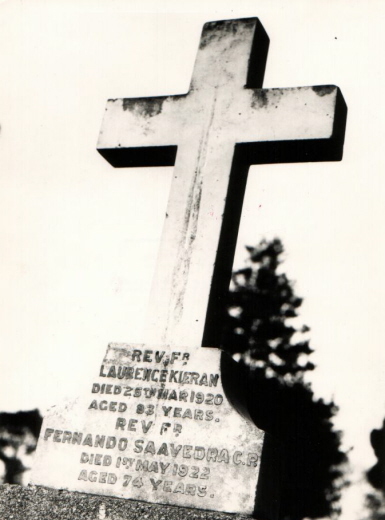
The above photograph of Fernando Saavedra’s gravestone has been sent to us by Harrie Grondijs (Rijswijk, the Netherlands). It was among the papers of John Selman, whose son Frank gave it to our correspondent.
Pages 17-23 of Mr Grondijs’ book No Rook Unturned (Rijswijk, 2004) contain many details about Georges Barbier, together with a picture of him. We have now received from Dominique Thimognier (St Cyr sur Loire, France) a different shot, published on page 96 of The Glasgow Athenaeum: A Sketch of Fifty Years’ Work (1847-1897) by James Lauder (Glasgow, 1897):
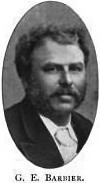
Mr Thimognier also submits a passage about Barbier in Le Matin of 30 October 1894:
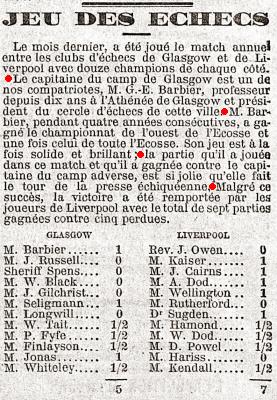
The game praised by the column was given on pages 419-420 of the October 1894 BCM:
Georges Emile Barbier – John OwenGlasgow, 22 September 1894
Queen’s Fianchetto Defence
1 e4 b6 2 d4 Bb7 3 Nc3 e6 4 f3 d6 5 Nh3 Be7 6 Nf2 Nf6 7 Be3 Nbd7 8 Be2 O-O 9 O-O c6 10 f4 Re8 11 e5 Nd5 12 Nxd5 exd5 13 Bd3 Nf8 14 Qh5 Bc8 15 Ng4 g6 16 Nh6+ Kg7 17 Qf3 Kxh6 18 f5+ Bg5 19 f6 Bxe3+ 20 Qxe3+ g5 21 h4 Ne6 22 hxg5+ Nxg5

23 Rf4 Nh3+ 24 Kh2 Nxf4 ‘and White announced mate in five, including the sacrifice of Black’s bishop’ (Glasgow Citizen).
5806. Daily bulletins (C.N. 5800)
Jerry Spinrad (Nashville, TN, USA) quotes from the Brooklyn Daily Eagle of 10 March 1893, page 7:
‘An interesting feature of the coming chess congress will be the issue of the daily bulletin, which will be a chronicle of each day’s proceedings of the international tourney. At the close the bulletin will be bound in book form and become an official record of the congress of 1893.’
Plans for the event, the ‘Columbian Congress’, fell through. See, for instance, pages 11-18 of Adolf Albin in America by Olimpiu G. Urcan (Jefferson, 2008).
5807. Cambridge Springs, 1904 memorabilia

The above was published on page 27 of the June 1904 American Chess Bulletin. Has any reader ever come across one of these ‘souvenirs’?
5808. Rossolimo v Livingstone (C.N.s
3815 & 4047)
We note that Rossolimo’s brilliancy against Livingstone at New York, 1961 (with the spectacular move 18 c4) was published, with no further details concerning the occasion, on page 204 of Schach-Echo, 8 July 1961.
5809. Judd v Haller
John Hilbert (Amherst, NY, USA) sends this game from the St Louis Globe Democrat, 11 July 1885:
Max Judd – Lewis T. HallerSt Louis, 1885
(Remove White’s queen’s knight.)
1 e4 e5 2 Nf3 Nc6 3 Bc4 Nf6 4 O-O Bc5 5 b4 Bxb4 6 c3 Ba5 7 d4 exd4 8 cxd4 O-O 9 d5 Ne7 10 e5 Ne8 11 d6 cxd6 12 exd6 Nf5 13 Ng5 h6 14 Nxf7 Rxf7 15 Bxf7+ Kxf7 16 Qd5+ Kg6 17 g4 Nfxd6 18 Ba3 Bc7 19 Qd3+ Kf7 20 Qd5+ Kf8 21 Rae1 Qf6
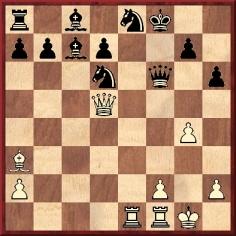
22 Rxe8+ Kxe8 23 Qg8+ Ke7 24 Re1+ Qe6 25 Qxg7+ Kd8 26
Qf8+ Ne8 27 Qe7+ Qxe7 28 Bxe7 mate.
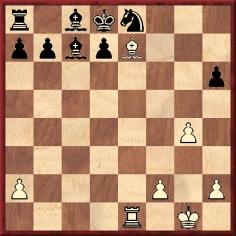
5810. David Mitchell
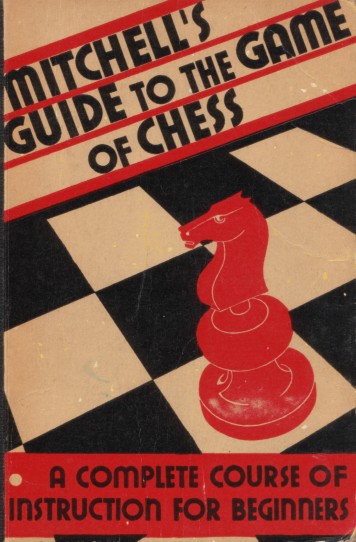
Further to our feature article Disappeared, Russell Miller (Camas, WA, USA) provides some additional biographical information gleaned from Ancestry.com.
The 1900 Federal Census (Philadelphia Ward 15, Philadelphia, PA) stated that David Andrew Mitchell, aged 16, was living with his parents William Mitchell (who was born in Ireland on 2 February 1836 and emigrated to the United States in 1854) and Isabella F. Mitchell (born in Ireland on 27 April 1848 and emigrated to the United States in 1858).
David Mitchell’s Draft Registration Card for the Great War (15 September 1918, Chester County, PA) gave his occupation as ‘Editor, Public Ledger’ and his employer as Cyrus Curtis. Some personal details were also included: ‘Height: Tall. Build: Slender. Eyes: Blue. Color Hair: Light.’
5811. Captain Evans
Luc Winants (Boirs, Belgium) informs us of a video report about the grave of Captain William Davies Evans in Ostend. It shows a fourth photograph of Evans (in addition to those given in C.N. 4878).
5812. King and queen
Ola Winfridsson (Cambridge, England) asks what is known about an episode related on page 41 of The Art of Attack in Chess by Vladimir Vuković (London, 1998) concerning the position after 25 Kd5 in Chigorin v Caro, Vienna 1898:
Vuković wrote:
‘This position caused amazement among some of the spectators, who attempted to get the manager of the tournament to intervene, since it was clear that White’s piece on d5 was his queen and that on b1 his king.’
We note what appeared on page 91 of the tournament book by H. Fähndrich, A. Halprin and G. Marco:
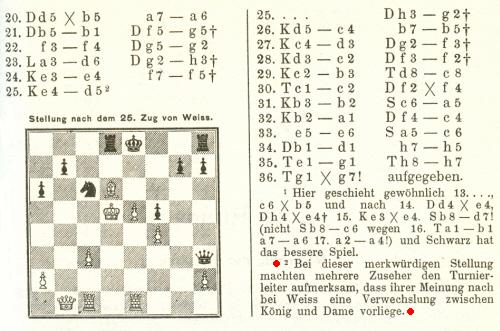
5813. Fischer v whom?
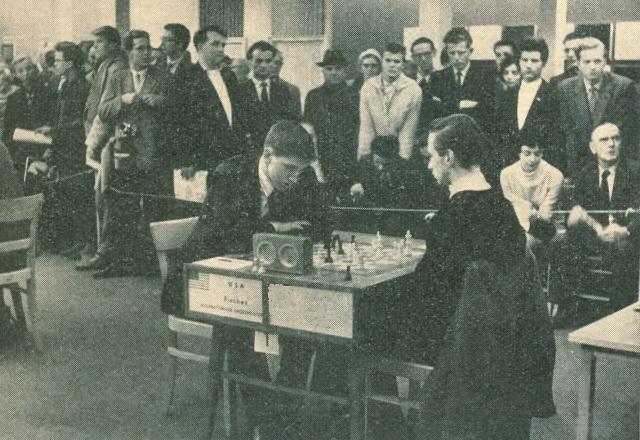
5814. ‘Fahrni v Alapin’
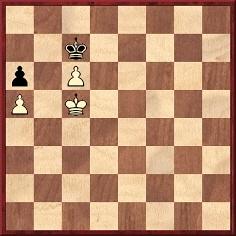
Regarding this position (discussed on pages 42-43 of A Chess Omnibus and in C.N.s 5157 and 5178), a number of points have been made:
- It is usually given with a caption ‘Fahrni v Alapin’, sometimes with a date between 1909 and 1917 and occasionally with a mention of Munich as the venue.
- Fahrni provided the position on page 15 of his book Das Endspiel im Schach (Leipzig, 1917), with the vague heading ‘From a game Fahrni-Alapin’.
- The position after 1 Kd5 Kc8 arose in Fiebig v Tartakower, Barmen, 1905, but White missed the win.
- A similar ending arose in W. Lange v C. Carls, Aachen, 1934. White’s king was on e2 and he had a pawn on h3. Black’s king was on e4 and he had pawns on f4 and h4.
- A more recent example is Alburt v Kasparov, Daugavpils, 1978.
- The ending also appeared in volume one of Finales de ajedrez by Ramón Rey Ardid (Saragossa, 1944). It was included too on page 82 of the March 1911 La Stratégie; that item mentioned neither Fahrni nor any other player, but Michel A. Tossizza gave an extract from his 1910 book Etude explicative d’une partie d’échecs. Le Gambit Evans. (Does any reader have a copy of that work?)
- The position in the diagram above appeared in Emanuel Lasker’s Common Sense in Chess, which was first published in 1896. Depending on the edition, the page numbers are 108-110, 108-109 or 126-127.
- The position was ascribed to Kling and Horwitz in Carlo Salvioli’s book Il giuoco degli scacchi (various editions). See also page 6 of Chess Studies and End-Games by B. Horwitz and J. Kling (London, 1889), where the units were placed one file to the right.
Now we are grateful to Harold van der Heijden (Deventer, the Netherlands) for the following additional information:
- Rey Ardid’s above-mentioned book gave the position twice: on page 82, where it had the heading ‘Fahrni-Alapin’, and on pages 209-210, where it was ascribed to Kling and Horwitz. Rey Ardid also referred, on page 210, to the Lange v Carls game.
- Page 66 of Végjáték iskola by J. Bán (Budapest, 1965) also mentioned Kling and Horwitz (1879).
- Page 56 of Studie by F. Dedrle (Prague, 1925) referred to Lasker’s Common Sense in Chess.
- Page 12 of the 1851 edition of Kling and Horwitz’s
Chess Studies had this position:
- On page 16 of the 1884 Horwitz edition, a slightly different version was given (with the white king on c1 instead of d1) but with a similar solution.
- The original position and solution were reproduced on page 64 of Recueil d’études progressives sur les fins de parties au jeu des échecs by J. Preti (Paris, 1858). The version with a white king on c1 was published, with the same solution, on page 33 of Trattato completo dei finali di partita by C. Salvioli (Venice, 1888).
- That position is to be found on page 391 of J. Berger’s Theorie und Praxis der Endspiele (Leipzig, 1890) and indirectly results in Fahrni’s Zugzwang: After 1 a5 bxa5 2 Kd1 Berger also gave the line 2…Kd4 3 Kc2 Kc4 4 Kc1, and now noted that 4 a3 was not possible owing to 4...Kd4 5 Kc1 a4 6 Kc2 Kc4, etc. That may be the first time that this Zugzwang occurred in print. On page 549 of the second edition of his book (Berlin and Leipzig, 1922), Berger incorrectly stated that the version with a white king on c1 had appeared in the 1851 book by Kling and Horwitz.
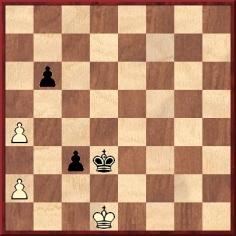
The intention is 1 a5 bxa5 2 Kc1 a4 3 Kd1 Kd4 4 Kc2 Kc4 5 a3 (the ‘Fahrni position’). Black now wins with 5…Kd4, and there are further problems with the Kling and Horwitz solution. For example, 1 Kc1 draws, 3…c2+ wins, and both 5 Kd1 and 5 Kb1 draw.
5815. At Purkersdorf

Maya Katz (Teaneck, NJ, USA) asks whether any information is available on the above photograph, taken at the Purkersdorf Sanatorium in 1935.
5816. Bohatirchuk
Yakov Zusmanovich (Pleasanton, CA, USA) sends this photograph, taken by Irene Ben-Tchavtchavadze, of the grave of Fedor Bohatirchuk:
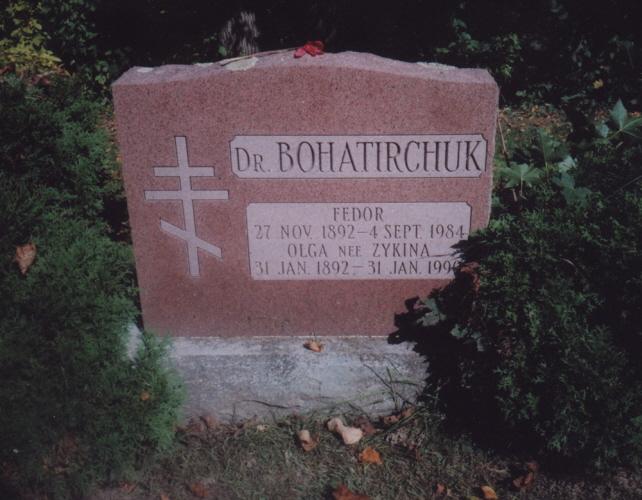
Our correspondent adds:
‘Currently I am cooperating with Sergey Voronkov on his book about Bohatirchuk. We are going to re-issue Bohatirchuk’s volume Moi zhiznenny put’ k Vlasovu i Prazhskomu Manifestu, which was published in Russian in San Francisco in 1978. In addition to Bohatirchuk’s own text, the book will include a collection of his games, articles and documents. There will be an extensive introduction by Boris Spassky.
We are seeking further material related to Bohatirchuk’s chess and scientific careers, including photographs, caricatures, articles, games and score-sheets, and we are particularly interested in the games from Bohatirchuk’s match against Stepan Popel in Cracow and from a tournament in Radom. Both events took place in 1944.’
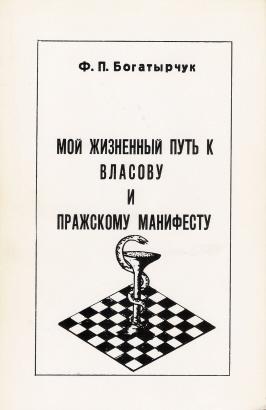
Any readers who may be able to help Mr Zusmanovich are invited, in the first instance, to contact us.
5817. Back rank
Following on from our feature article Adams v Torre – A Sham?, João Pedro S. Mendonça Correia (Lisbon) refers to another position leading to the back-rank theme. It comes from a game played in the first half of the 1880s in which Siegbert Tarrasch was White against Bernhard Richter:
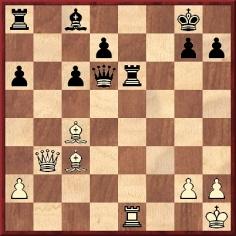
After 1...Kh8 (given a question mark by Tarrasch) White won with 2 Bxe6 dxe6 3 Rd1 Qc7
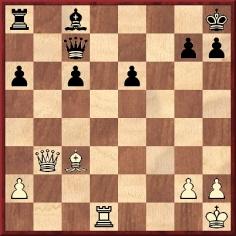
4 Ba5 Qxa5 5 Qb4 Resigns.
Source: Dreihundert Schachpartien by S. Tarrasch (Leipzig, 1909), page 43. See also page 37 of the English edition Three Hundred Chess Games (Park Hill, 1999). The position appeared too on pages 262-263 of Tarrasch’s book Das Schachspiel (Berlin, 1931) and pages 186-187 of The Game of Chess (London, 1935).
It may be recalled from page 29 of Chess Explorations that C.N. 53 gave, with the winner’s notes, the game below:
Lorenzo Ponce-Sala – J. ParpalBarcelona, 1950
Sicilian Defence
1 e4 c5 2 Nf3 d6 3 d4 cxd4 4 Nxd4 Nf6 5 Nc3 g6 6 Be2 Nc6 7 Be3 Bg7 8 f4 Qb6 9 Nf5 Qxb2 10 Nxg7+ Kf8 11 Bd2 Kxg7 12 Rb1 Qa3 13 O-O Nd4 14 e5 Nxe2+ 15 Qxe2 dxe5 16 fxe5 Qc5+ 17 Be3 Qxc3 18 exf6+ exf6 19 Rb3 Qe5 20 Qd2 Bf5 21 Bh6+ Kg8 22 Re1 Qc5+ 23 Kh1 Qxc2
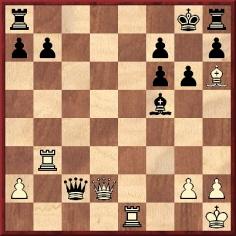
24 Rbe3 Qc6 25 Qd5 Be6 26 Qd4 Bd7
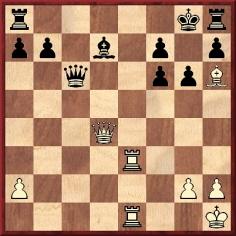
27 Re6 fxe6 28 Qxf6 Resigns.
Source: Estrategia y Táctica en Ajedrez by L.
Ponce-Sala (Barcelona, 1975), pages 95-96.
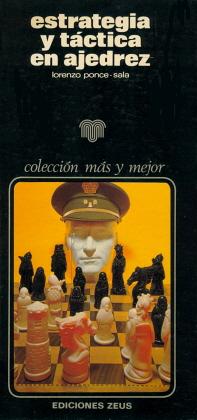
| First column | << previous | Archives [51] | next >> | Current column |
Copyright: Edward Winter. All rights reserved.
